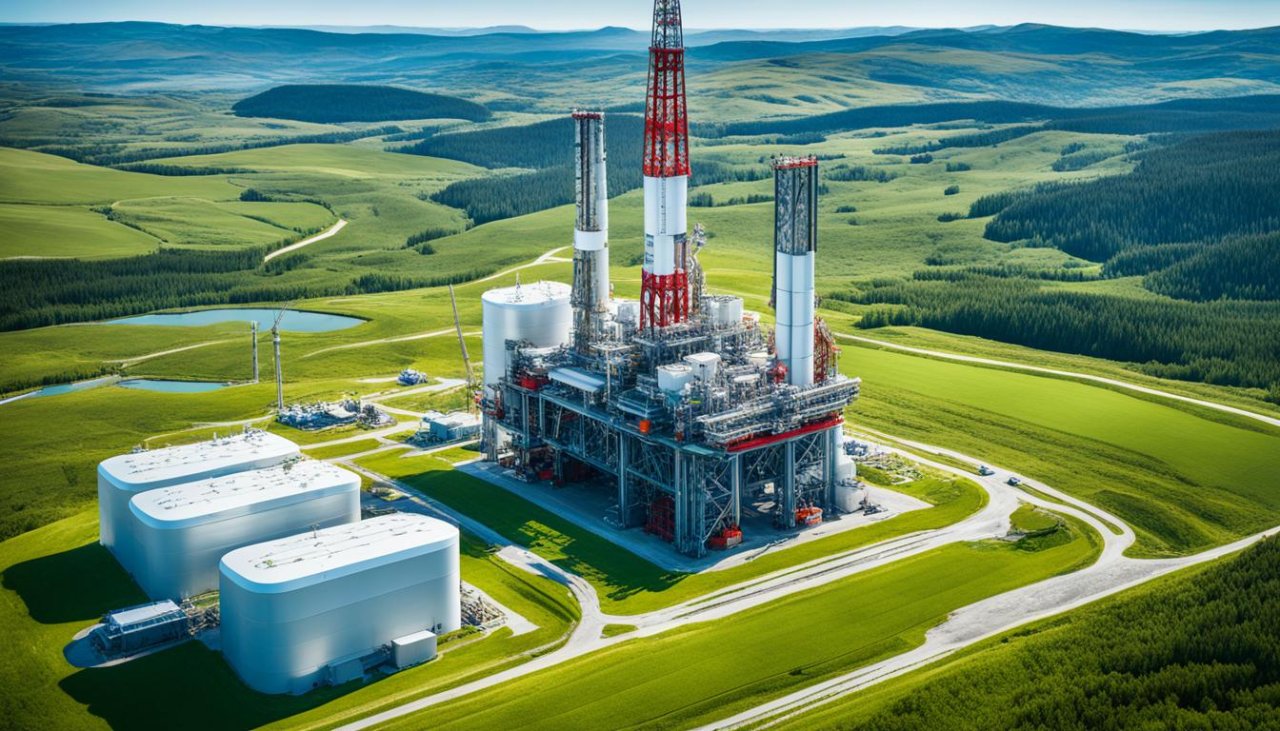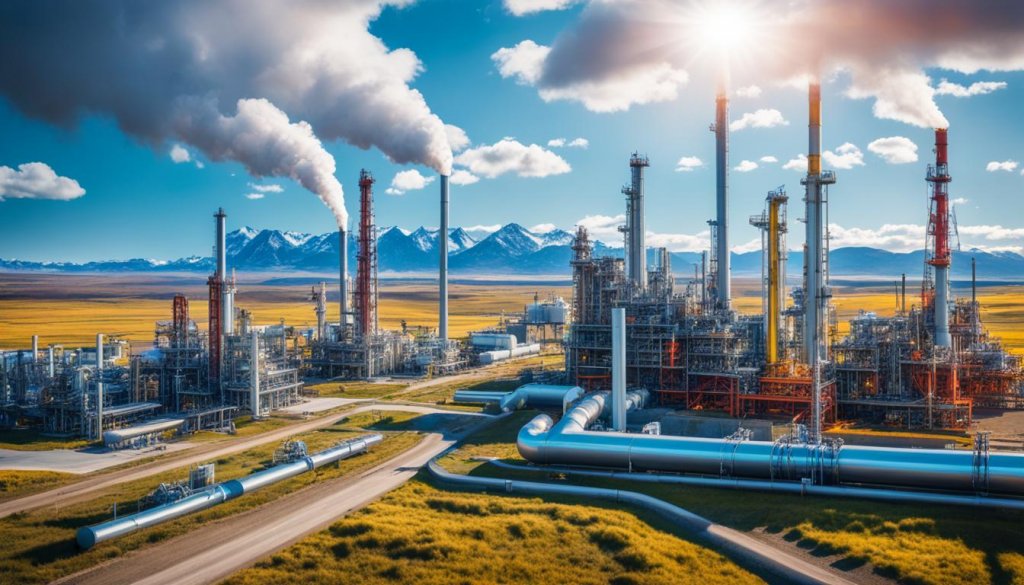As I stood on the edge of a vast oil field, the sun setting behind the horizon, I thought about how much the Oil and Gas Industry has changed. Just a decade ago, our methods of extracting and managing resources seemed old-fashioned. Now, with new technology and a focus on sustainability, staying ahead in this changing energy sector is more complex. In fact, 70% of leaders in the oil and gas industry believe that changing their whole business is key to staying competitive.
Looking ahead to 2024, it’s vital to adopt strategies that make our businesses more efficient and in line with new trends. This means using artificial intelligence and blockchain technology, among others. Oil and gas companies are at a critical point where being innovative can lead to big growth and sustainability. Let’s explore five key strategies that can help your business not just survive but thrive in the future.

Key Takeaways
- Understanding enterprise-wide transformation is essential for competitiveness.
- Embracing artificial intelligence can improve operational efficiency.
- Blockchain enhances transparency and asset management in trading.
- IoT technology connects field assets for automated diagnostics.
- Sustainable practices are becoming increasingly important in the energy sector.
Understanding the Current Landscape of the Oil and Gas Industry
The oil and gas industry is facing many challenges that affect how it produces energy and makes strategic decisions. OPEC+ has cut output by 2.5 million barrels per day, making Brent oil prices go over US$90 per barrel. This change shows the oil and gas challenges from changing demand and the need to follow rules. The world’s oil demand is set to grow by 2.3 million barrels per day in 2023, hitting 100 million barrels per day. This shows the petroleum sector still depends on fossil fuels, even as interest in renewable energy grows.
Natural gas prices have also gone up, reaching US$3.50 per million British thermal units in early November 2023. This rise affects the industry’s economy, making companies rethink their investment plans. Even though there’s a big push for low-carbon tech, only 4% of upstream spending goes towards these efforts. About 60% of top executives say they’re ready to invest in low-carbon projects if they see returns of 12% to 15%.
For 2024, the global upstream industry is expected to invest a huge US$580 billion in hydrocarbons, showing its financial strength. Companies are now more into mergers and acquisitions, doing them in a smart way. The need for minerals like lithium, cobalt, and nickel has jumped as electric vehicles become more popular. This shows the mix of old energy production and new sustainable ways in the petroleum sector.
The Importance of Digital Transformation in Oil and Gas
Digital transformation is key in today’s fast-changing oil and gas world. It means using digital tech across the whole industry to make things more efficient and cheaper. This shift is crucial for the sector’s future.
What is Digital Transformation in the Oil and Gas Sector?
Digital transformation means using new tech like data analytics and artificial intelligence. These tools help update old systems that slow down the industry. Many companies still use old equipment, showing the need for change.
Handling data well is key. Companies must deal with huge amounts of information to make smart decisions and improve efficiency.
Benefits of Embracing Digitalization
Using technology in oil and gas brings big benefits. Digital projects can add more than $5 per barrel of oil. They help make better decisions, keep workers safer, and cut costs.
For example, companies save more than $1 per barrel by managing their supply chains better. Training workers for new tech helps them adapt faster to digital changes.
Key Trends Shaping the Oil and Gas Industry in 2024
The oil and gas sector is changing a lot as it faces new challenges and chances. Trends show a move towards new technologies and being more sustainable. These changes are key for the industry’s future success and flexibility.
Emerging Technologies in Oil and Gas
Generative AI is leading the way in making the oil and gas industry better. It helps cut costs and make processes more efficient. Many executives see its value in improving their operations.
The use of IoT and automation tools makes workflows smoother and safer. As the digital oilfield grows, spending on analytics and cloud computing will hit over USD 20 billion. This will start a new era of better productivity and smarter operations.
Impact of Sustainability and Renewable Energy
Companies are now focusing on being more sustainable. Over three-quarters of oil and gas leaders are looking into renewables. This move towards cleaner energy is getting stronger.
With governments aiming for net-zero emissions by 2050, companies are investing in renewable energy. Using renewable sources well will help companies look good and follow new rules. Adding carbon capture tech is another way to improve operations and meet environmental demands.

Accelerating Business Efficiency through Data Management
In the fast-paced oil and gas industry, managing data well is key to improving operations. Companies struggle with data silos that block teamwork and smart decision-making. By sharing data across departments, companies get instant access to important asset info. This leads to faster decisions and better strategies.
Breaking Down Data Silos for Improved Decision-Making
To make businesses run smoother, it’s vital to break down data silos. About 55% of firms find managing data a big hurdle. By looking at data as a whole, companies improve communication and use predictive maintenance to cut downtime by up to 35%. This makes operations smoother and cuts the need to watch over the workforce by 80%.
Leveraging Big Data and Analytics for Insights
Using big data analytics helps the oil and gas industry get valuable insights from large datasets. AI looks at production data to make drilling and managing resources better in shale reservoirs. By using machine learning, companies can get more efficient, potentially adding up to USD $250 billion in value by 2030. Cloud technology makes sharing data faster, helping with quicker decisions. These changes show how good data management is key to saving costs and improving performance in the oil and gas sector.
Establishing Strategic Partnerships in the Energy Sector
In the changing energy world, making strategic partnerships is key for oil and gas companies. These partnerships help bring new ideas and make operations more reliable. They give companies access to the latest technologies and skills needed to succeed in today’s market.
Strategic partnerships help oil and gas companies stay strong through changes in rules and shifting investor interests. Many companies are now looking into electrification and renewable energy. By working together, they can improve their ability to find sustainable solutions while thinking about the environment.
With the world needing responsible use of resources, I believe in strong industry collaboration. By working together, companies can make their businesses more sustainable. For example, Ørsted’s “People Positive” framework shows how partnerships can help with sustainability goals.
Looking into digital transformation, I see how it changes things. Using digital tech and AI in the energy sector makes partnerships even more powerful. Companies like ExxonMobil and Woodside Energy use advanced analytics and automation to get better at what they do. These changes help improve decision-making and make companies more competitive.
Implementing Innovative Technologies for Future Growth
The oil and gas industry is always looking to adapt with new technologies. By using AI and robotics, companies can make their operations better, safer, and set the stage for growth. It’s key to understand these technologies to stay ahead in a fast-changing world.
Artificial Intelligence and the Oil and Gas Industry
AI is a big deal in the oil and gas world. It helps make operations more efficient by using algorithms and data science. This means companies can better understand oil reservoirs and check on machines without waiting.
This leads to more production and cuts down on mistakes and costs. With AI, finding the best places to drill and keeping machines running smoothly is easier. This means safer and more productive work.
The Role of Robotics and Automation
Robotics and automation are changing the game in oil and gas. Drones are now used for checking up on facilities and oil wells from the air. This makes keeping an eye on structures and ensuring safety easier, especially in risky places.
Automation also means less need for people in dangerous jobs and more efficient energy production. Using these new techs lowers costs and helps us use resources better. As the industry keeps moving forward, the outlook for growth looks bright.

Fostering a Culture of Innovation within Oil Companies
In my experience, making a culture of innovation in oil companies is key today. With oil prices not moving much in years, the need to innovate grows. A survey by Accenture Strategy shows a big difference between leaders and workers. Leaders say they let employees be innovative, but workers don’t always agree. This shows how important it is to really empower the workforce for true innovation.
The energy sector often goes for a safe approach, focusing on low-risk choices. But this can stop creativity. Innovation is crucial for better operations, more work done, and staying ahead. Companies need to adopt new tech like AI, big data, and IoT to keep up.
Switching to remote work can help bring out new ideas and keep workers engaged. It’s important to listen to what employees say to make them feel part of the mission. This helps share ideas and makes a place for innovation.
Leaders must really support an innovative culture to help workers and improve the business. Creating a place where everyone’s ideas are welcome can lead to new discoveries. This helps oil companies keep up with changes in the market.
Enhancing Safety Measures and Compliance in Oil and Gas
Ensuring safety in the oil and gas sector is crucial. With the right strategies, organizations can boost safety and meet compliance goals. Over time, safety rules have changed to better handle risks. Agencies like OSHA, EPA, and DOT set standards to protect workers and the environment.
Utilizing Advanced Analytics for Safety Management
Advanced analytics change the game for safety in oil and gas. They use real-time data to spot hazards and track compliance. This helps companies act before risks happen, making safety better.
For example, analytics tools help look at past incidents to stop them from happening again. This lowers the fatality rate, which is still higher than in other fields.
Blockchain for Enhanced Asset Tracking
Blockchain technology makes asset tracking safer and more compliant in oil and gas. It adds a new level of security and helps companies follow the law easily. By keeping a secure record of all transactions, companies can handle risks better, especially with dangerous materials.
This makes it easier to follow safety rules, creating a safer place to work.
Best Practices for Oil Drilling and Natural Gas Exploration in 2024
Keeping up with the latest in oil drilling and natural gas exploration is key for success. Using advanced techniques can make processes smoother and reduce harm to the environment. For example, infrared cameras help find leaks, making things safer and helping us use resources better.
Ultra Resources in Houston shows how new methods can lead to big wins. They use a flowback unit that recycles 2,000 bbls of water, avoiding the use of fresh water since 2007. This saves money on water handling and disposal, showing how efficient gas exploration can be.
Technologies like vapor recovery units and dehydrators cut down on harmful emissions. Switching to engines that emit less pollution shows a big commitment to being green in the oil and gas world. Also, smart planning and automation in drilling are key to doing things better.
Going to the 2024 Summer Exploration and Production Standards Meeting is a great way to learn new things. It brings together experts who want to improve their skills in oil drilling and follow the rules better.
Using Directed Inspection and Maintenance programs helps spot and fix gas leaks. Also, Reduced Emissions Completions (RECs) capture gases during completion, cutting down on venting or flaring. This is a big step towards lessening our environmental impact.
As we head into 2024, embracing these best practices will make the oil and gas industry more efficient, safe, and green.
Leveraging Renewable Resources to Augment Fossil Fuels
The oil and gas industry is changing fast. Adding renewable resources is a key part of this change. It helps meet energy needs while protecting the planet. This move is good for both the environment and business success.
The Future of Sustainable Practices in the Petroleum Sector
In 2020, renewables became the cheapest energy source worldwide. This shows a big shift towards sustainable energy. Companies like Shell are leading with plans for 500,000 electric vehicle charging points by 2025.
Big names like Chevron and ExxonMobil are also investing in cleaner energy. Chevron plans to spend $10 billion on lower carbon projects by 2028. ExxonMobil aims for net-zero emissions by 2050. These moves show they understand the need for sustainability.
Carbon capture technology is a big hope for reducing emissions. As companies turn to renewables, they can use new tech like hydrogen fuel cells and CCUS. This helps them meet emission goals and gain customer trust.
The future will see a mix of fossil and renewable energy. Fossil fuels will still be part of the mix because they’re cheaper. But, investing in low-carbon options can really pay off, as McKinsey’s 2022 report shows.
Working with sustainable practices is key for the petroleum sector’s future. This shift can create new jobs in areas like wind and solar. Investing in these areas can boost both the economy and the environment. It’s important to keep innovating for a better energy future.
Conclusion
The oil and gas industry is at a key moment. It needs to focus on future-proofing strategies more than ever. With a possible 45% demand drop by 2050 if climate goals are met, companies must change to stay relevant and sustainable.
Looking back at the main points, digital transformation, new technologies, and strategic partnerships are key to business strength. The industry must see that investing in clean energy is crucial. Right now, less than half of global production aims to cut emissions.
The future of oil and gas depends on innovation and growth. Even with the challenges of changing demand and environmental issues, those who adopt strong future-proofing strategies will do well. They will not just survive but succeed in the new global market.
See how FieldAx can transform your Field Operations.
Try it today! Book Demo
You are one click away from your customized FieldAx Demo!
FAQ
What are the primary challenges facing the Oil and Gas Industry in 2024?
The Oil and Gas Industry faces challenges like changing oil prices, new rules, and a push for sustainability. They also need to use more renewable energy. These issues call for strategic changes for success.
How can digital transformation benefit oil and gas companies?
Digital transformation makes operations more efficient by using digital tech across the Oil and Gas industry. It cuts costs, helps in making better decisions, and makes workers safer. It also boosts sustainability with tools like drones and virtual reality.
What emerging technologies should oil and gas companies consider in 2024?
Companies should look into Artificial Intelligence (AI), the Internet of Things (IoT), and robotics. These technologies improve efficiency, safety, and sustainability in energy production. They show the industry’s move towards new solutions.
Why is data management crucial for oil and gas businesses?
Good data management helps companies work better together and make smarter decisions. By using big data analytics, they can learn from production data. This leads to better performance and lower costs.
How can partnerships enhance innovation in the energy sector?
Working with tech companies gives oil and gas firms access to new tools and expertise. This teamwork leads to more innovation and reliable operations. It also helps in adopting new technologies better.
What role does a culture of innovation play in oil companies?
A culture of innovation encourages creative thinking and empowers workers. By training teams at all levels, companies can get them ready for new tech. This helps overcome the usual resistance to change in such industries.
How can advanced analytics improve safety in the Oil and Gas Industry?
Advanced analytics helps manage safety by spotting potential dangers and making compliance easier. It also uses blockchain for transparency and tracking assets. This ensures companies meet rules and reduce risks in managing assets.
What are the best practices for oil drilling and natural gas exploration in 2024?
Top practices include using the latest drilling methods, focusing on efficiency, following safety rules, and being sustainable. Knowing these practices helps companies produce more while protecting the environment.
How can the Oil and Gas Industry leverage renewable resources?
The industry can use sustainable practices to support traditional fossil fuels. This approach meets growing energy needs and tackles environmental issues. It also helps meet global climate goals.
Author Bio
Co-Founder & CMO at Merfantz Technologies Pvt Ltd | Marketing Manager for FieldAx Field Service Software | Salesforce All-Star Ranger and Community Contributor | Salesforce Content Creation for Knowledge Sharing






